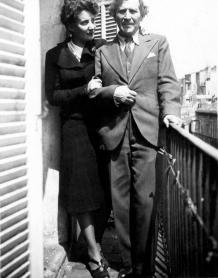Marc Chagall, painter

He was born Moses Chagaloff on 7 July 1887 in Vitebsk, in what is now Belarus. He was the eldest of nine children from a modest family of Hasidic Jews. He travelled to Saint Petersburg at the age of twenty after demonstrating a tremendous flair for drawing, where he studied painting while working odd jobs.
Marc Chagall enthusiastically embraced the Bolshevik Revolution in 1917, which put an end to the war and saw Jews declared equal citizens. He became the Commissioner of Arts in Vitebsk, directed an art school, and organised festivals and revolution-oriented events. However, local communist leaders did not appreciate his art and he was criticised for "lacking revolutionary vision". In 1922, he relinquished his duties and he left his country, refusing to allow his art to be censored and to be driven into poverty.
It was in Paris, where he had already stayed from 1911 to 1914, that Marc Chagall settled as a refugee. He continued to paint and acquired considerable fame. However, labelled a "degenerate artist" by the Nazis, he had to flee the Vichy regime which, in 1943, stripped him of his French citizenship. Indeed, he had initially been denied French citizenship before finally being approved for the same in 1937. Thanks to an invitation from the Museum of Modern Art (MoMA) in New York and the involvement of the Rescue Committee, Chagall left France at the end of 1940 to take refuge with his family in New York during World War II.
At the end of the war, Marc Chagall's French citizenship was restored. He achieved acclaim on a global scale and attended retrospectives of his work at MoMA, then in Paris and elsewhere in Europe. He returned to Paris in 1948 and initially settled in Orgeval before moving to Vence in 1950. In the south of France, he began to diversify his artistic techniques with a focus on ceramics, sculpture, stained glass and mosaics. For 20 years, he responded to numerous commissions related to monuments, public and private alike. In September 1964, in response to André Malraux's commission, he painted the ceiling of the Opéra Garnier. In 1966, he donated the works of the Biblical Message series to the French State, which led to the creation of the Marc Chagall Biblical Message National Museum (now called Marc Chagall National Museum) in Nice, which opened in 1973.
He died on 28 March 1985 in Saint-Paul de Vence. He was awarded the Grand-croix de la Légion d’honneur (Grand Cross of the Legion of Honour).